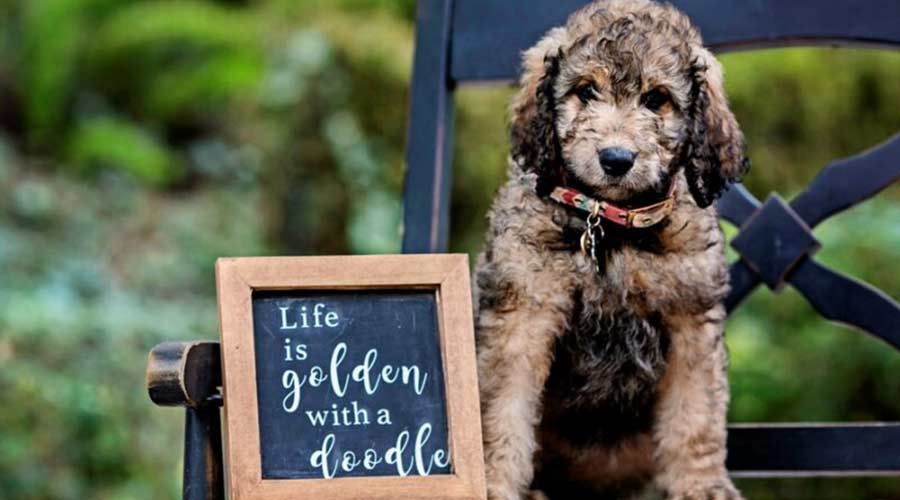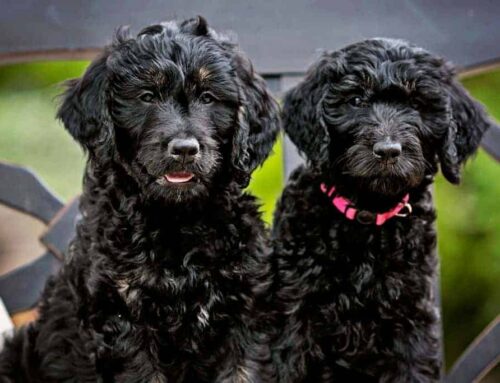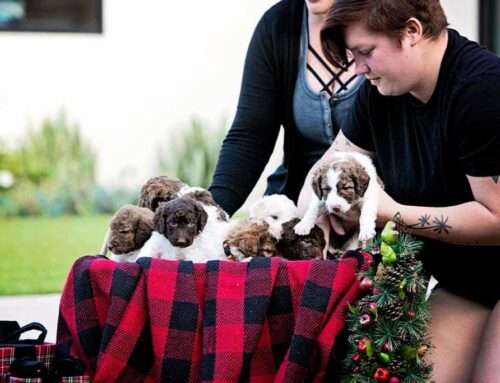A Goldendoodle’s size is somewhere between that of its golden retriever parent and poodle parent. These beautiful dogs look cuter in different sizes. But the most important thing is how we can pick a suitably sized dog for us. Understanding the differences in sizes is essential for finding the perfect match for your lifestyle and preferences. In this guide, we’ll delve into everything you need to know about Goldendoodle sizes.
Different Goldendoodle Sizes
There are many special features to tell about this gorgeous dog breed. One of them is height. Golden doodles are classified into three sizes. You can prefer to select your dog with a size with which you are compatible. These three sizes are:
- Standard Goldendoodle
- Miniature Goldendoodle
- Petite/Toy Goldendoodle
Let’s take a look at each of their size, weight, and height:
Standard Golden doodle
Goldendoodles are ultimate in coat, personality traits, intelligence, and size. When a golden retriever is mated with a standard size poodle, the resulting puppies are standard sized. These dogs are 22 inches higher when grown completely. This measurement is from the ground to the shoulder. Due to the Goldendoodle gender difference the weight of males varies from the weight of the female. Male weighs from 55 kg to 70 kg. Whereas, a fully grown female can weigh from 50 kg to 60 kg. Keep in mind that standard size is the largest Goldendoodle size.
Besides being large, standard Goldendoodle are extremely good buddies and are also efficient in security. Therefore, people who like large but polite dogs should go for this size.
Miniature Goldendoodles
Sometimes dog owners want a cute dog in a medium-size, the dog that may not need a spacious living place and heavy meals. Miniature Goldendoodle is the perfect choice for them.
This is the medium size in the list of Goldendoodles. The size of full-grown miniature Goldendoodles is between 16 to 20 inches high from ground to shoulder in height. Moreover, the weight of males and females is almost the same when fully grown. They weight between 35 kg to 50 kg.
These are the best dogs for the people living in large houses with fenced yards, as well as the people living in lodges or townhomes.

Petite/Toy Goldendoodles
Petite/toy Goldendoodles, as the name suggests, are small cute furry animals that are best for those who want a smaller and adorable pet. Their weight is around 20-35 pounds, and they are 15 inches in height.
How to Measure Goldendoodle size:
Before we move on with the discussion about Goldendoodle size, I will like to add the method of measuring the dog. When we talk about size, we mean the height and weight of the dog. The way of measuring height is to measure the dog from ground to shoulder in a standing position. The weight of the dog is measured as the normal body weight measurement i.e., by standing dog on a weight machine.
Factors Influencing Goldendoodle Size
The size of a Goldendoodle, a popular hybrid breed resulting from crossing a Golden Retriever and a Poodle, can vary widely. Several key factors influence their eventual size, including the parent breeds, genetics, nutrition, and overall health and wellness. In this part we will discuss about it.
Parent Breeds:
The size of a Goldendoodle primarily depends on the size of its parent breeds. Golden Retrievers are typically medium to large dogs, while Poodles come in various sizes: standard, miniature, and toy. A Goldendoodle with a standard Poodle parent is likely to be larger than one with a miniature or toy Poodle parent.
Genetics:
Genetics play a crucial role in determining a Goldendoodle’s size. The specific combination of genes inherited from each parent can influence not only the size but also the growth rate and final stature of the dog. While it’s possible to estimate size based on parentage, there can still be considerable variability within litters.
Nutrition:
Proper nutrition is essential for healthy growth and development. A balanced diet tailored to the dog’s life stage supports optimal growth. Overfeeding can lead to obesity, while underfeeding can result in stunted growth, both of which can affect the dog’s final size.
Health and Wellness:
Overall health and wellness significantly impact a Goldendoodle’s size. Regular veterinary care, vaccinations, and a healthy lifestyle ensure that growth occurs at a normal rate. Health issues or neglect can hinder proper development, leading to size variations.
Things to Consider when Choosing Goldendoodle Sizes:
There are Various factors you need to consider before choosing the right Goldendoodle sizes. We are discussing these Factors in detail.
Living Space:
Assess your living situation, including the size of your home and whether you have a yard. Larger Goldendoodles may require more space to roam and play. If you have a yard, assess its size and suitability for a Goldendoodle. Larger dogs may appreciate a spacious yard for running and playing, while smaller dogs can still thrive in smaller outdoor spaces with regular walks and playtime.
Activity Level:
Consider your activity level and how much exercise you can provide for your Goldendoodle. Larger sizes may need more physical activity to stay healthy and happy. Besides, If you enjoy long runs, outdoor adventures, or hiking with Goldendoodles, a larger Goldendoodle may be a better fit. Smaller Goldendoodles may still enjoy these activities but may not require as much physical exertion.
Allergies Problem:
Although no dogs are entirely hypoallergenic, Goldendoodles are still considered hypoallergenic dogs. Generally, smaller Goldendoodles shed less and produce fewer allergens compared to larger ones. If anyone in your household has allergies, you may want to opt for a smaller size. Still to minimize allergic reactions, Goldendoodle owners with allergies should follow some important tips.
Life Styles:
Think about what size of dog you prefer and what fits best with your lifestyle. Some people prefer smaller dogs for easier handling, while others prefer larger dogs for companionship and protection.

Health Considerations:
Larger dogs tend to have shorter lifespans and may be more prone to certain health issues such as hip dysplasia. Smaller dogs may have longer lifespans but may be more prone to dental problems.
Grooming Requirements:
Larger Goldendoodles may require more grooming due to their larger size and more hair. Consider whether you have the time and resources to dedicate to grooming.
Travel Considerations:
If you plan to travel frequently with your Goldendoodle, consider the size of the dog in relation to your vehicle and any travel restrictions. Miniature Goldendoodles are very much travel friendly. They can comfortably fit in a travel carrier or on a car seat, making them suitable for road trips, flights, and public transportation
In conclusion, selecting the right Goldendoodle size is crucial for a happy companionship. Consider factors like living space and activity level to ensure a harmonious fit. With our guide, make an informed decision and enjoy a fulfilling journey with your furry friend.




